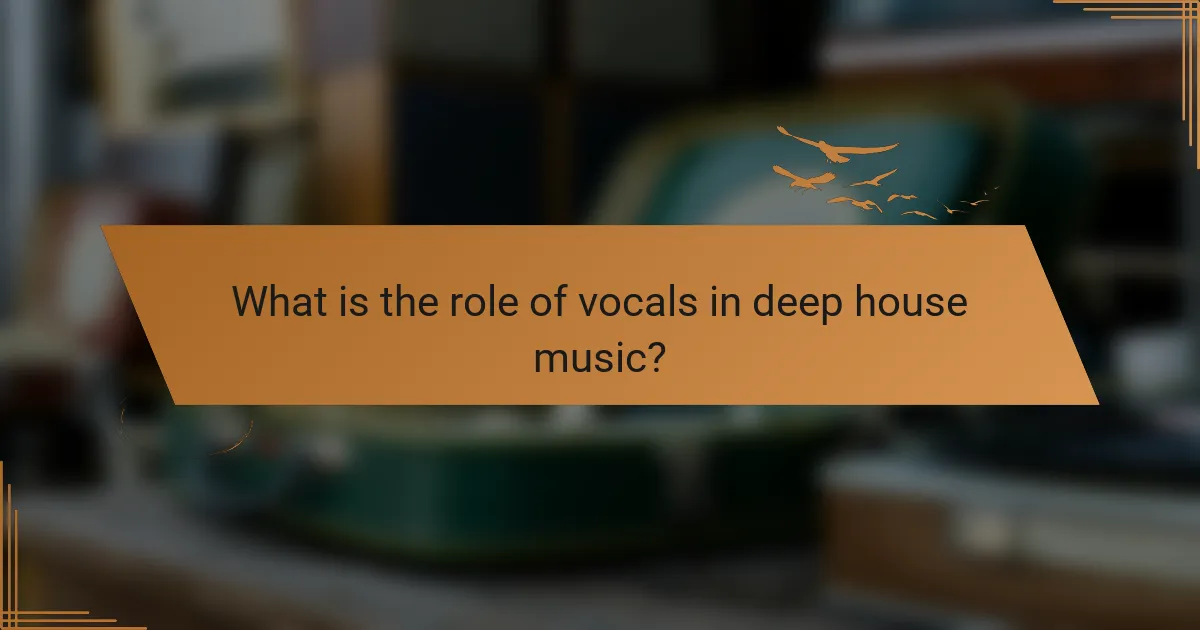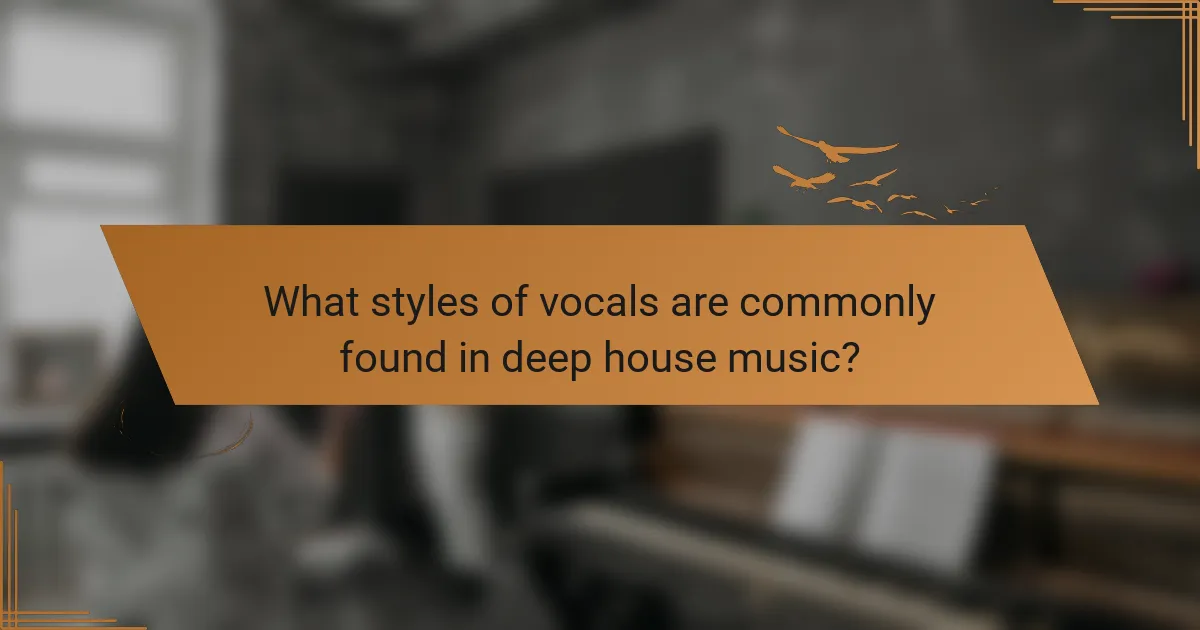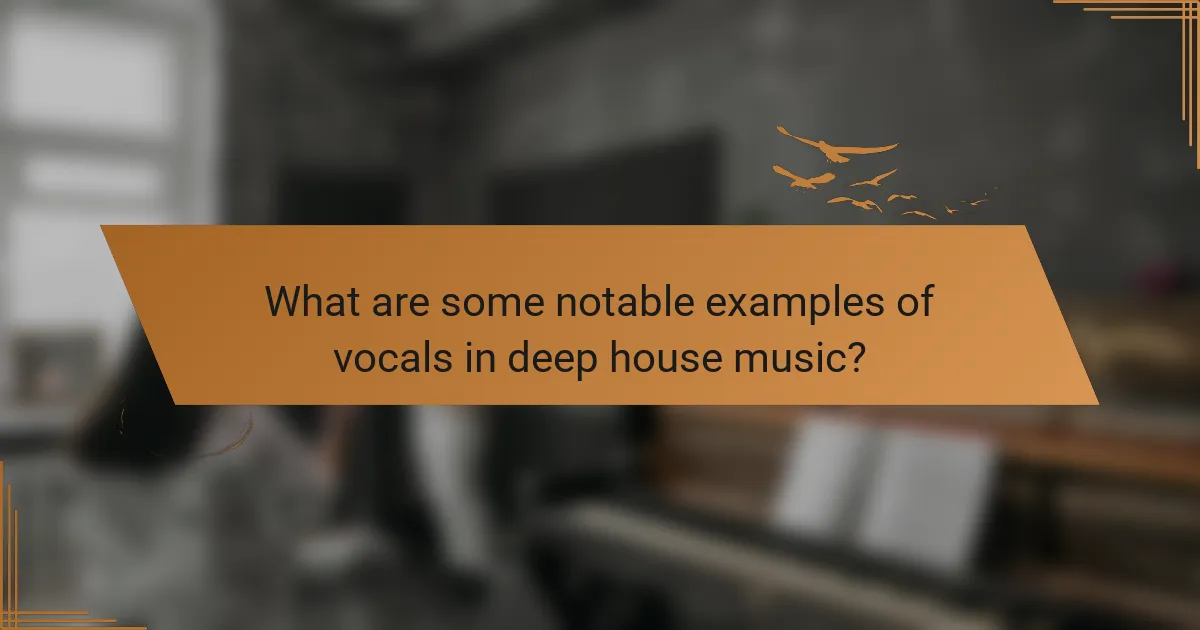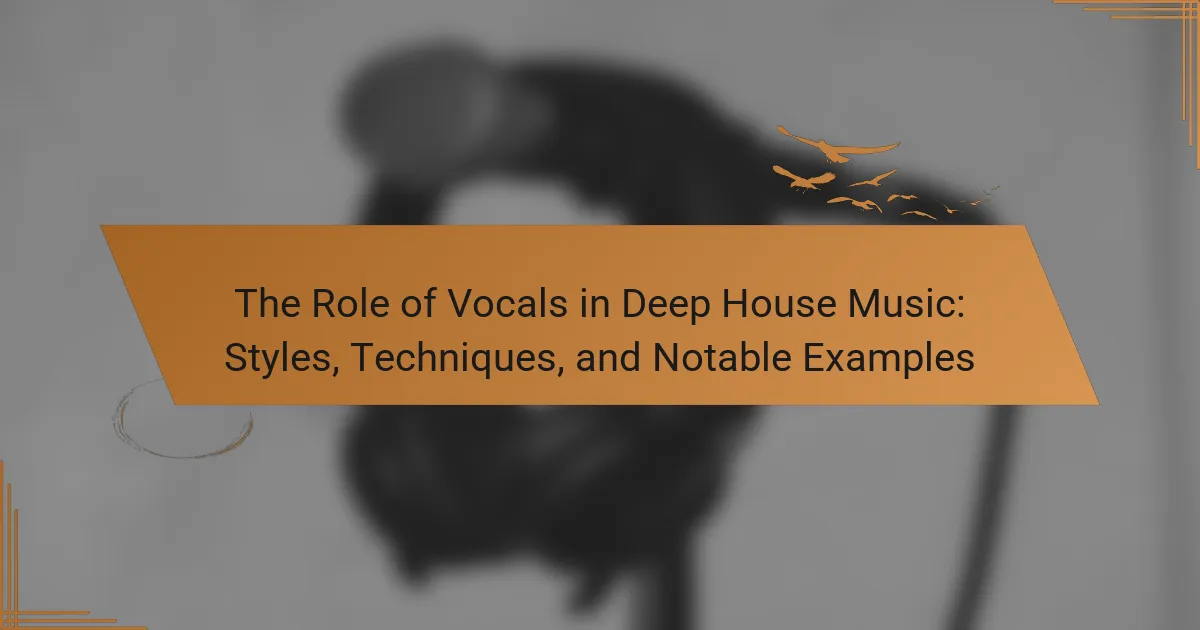Vocals in deep house music are essential for enhancing emotional connection and establishing atmosphere within the genre. They typically feature soulful melodies and reflective lyrics, contributing to the intimacy and depth of tracks. Vocal styles often draw from R&B and jazz influences, with both female and male vocalists providing a range of emotive tones. Techniques such as vocal sampling and the use of effects like reverb and delay further enrich the sound, creating a hypnotic and immersive experience. Notable examples of deep house tracks that showcase the significance of vocals include “Can’t Get Enough” by Soulsearcher, “Finally” by Kings of Tomorrow, and “Deep End” by John Summit, each demonstrating how vocals shape the emotional depth and overall appeal of the music.

What is the role of vocals in deep house music?
Vocals in deep house music serve to enhance emotional connection and establish atmosphere. They often feature soulful melodies and reflective lyrics. This creates a sense of intimacy and depth in the tracks. Vocals also complement the genre’s characteristic smooth and laid-back beats. They can be used sparingly or prominently, depending on the desired effect. For instance, many deep house tracks utilize vocal samples to create hooks. This approach maintains the genre’s rhythmic focus while adding a human element. Additionally, the use of vocal effects like reverb and delay contributes to the immersive sound. Overall, vocals play a crucial role in shaping the identity of deep house music.
How do vocals contribute to the overall sound of deep house music?
Vocals significantly enhance the overall sound of deep house music. They add emotional depth and connect listeners to the track. Deep house often features soulful, smooth vocal styles that complement the genre’s melodic elements. These vocals can range from simple phrases to intricate harmonies. The use of vocal samples is common, creating a layered texture in the music. Vocals also influence the rhythm and flow of a deep house track. They can guide the listener’s experience and evoke specific feelings. Ultimately, vocals are essential for creating a distinct identity within deep house music.
What are the key characteristics of vocals in deep house tracks?
Vocals in deep house tracks typically feature smooth, soulful tones. They often incorporate a laid-back delivery that complements the genre’s relaxed vibe. Vocals tend to be processed with effects like reverb and delay, enhancing their atmospheric quality. Lyrics in deep house often explore themes of love, longing, and introspection. The use of vocal samples is common, adding texture and depth to the sound. Female vocals are frequently prominent, contributing to the genre’s emotional resonance. Harmonies and layered vocals are also utilized to create a rich audio experience. These characteristics collectively define the unique vocal style found in deep house music.
How do vocals interact with other musical elements in deep house?
Vocals in deep house interact with other musical elements by complementing the rhythmic and harmonic structures. They often provide emotional depth and enhance the overall atmosphere of the track. Vocals can be layered with synths and basslines to create a rich sound texture. The use of reverb and delay effects on vocals adds spatial dimensions. Vocal samples are frequently manipulated to fit the tempo and mood of the music. This interaction creates a seamless blend between the voice and instrumental elements. Studies show that in deep house, vocals can drive the energy and engagement of listeners. The combination of vocals with deep basslines is particularly effective in maintaining groove and flow.
Why are vocals important in creating emotional connections in deep house music?
Vocals are crucial in deep house music for establishing emotional connections. They convey feelings and narratives that resonate with listeners. The human voice adds a personal touch, making the music more relatable. Vocals can express vulnerability, joy, or longing, enhancing the emotional depth of a track. Research indicates that songs with vocals can evoke stronger emotional responses than purely instrumental pieces. For instance, a study by Juslin and Laukka (2003) found that vocal music significantly impacts emotional expression. This emotional engagement is essential in deep house, where atmosphere and mood are key elements. Therefore, vocals play a vital role in creating a profound listener experience in deep house music.
What techniques do artists use to evoke emotions through vocals?
Artists use techniques such as vocal dynamics, pitch modulation, and phrasing to evoke emotions through vocals. Vocal dynamics involve varying volume levels to convey intensity or softness. Pitch modulation allows artists to express feelings by altering their vocal range. Phrasing refers to the way lyrics are delivered, which can create tension or release. Additionally, the use of vocal effects, like reverb and echo, enhances emotional depth. Artists also employ breath control to add vulnerability or strength to their delivery. These techniques are essential in deep house music, where emotional connection is crucial for audience engagement.
How do vocal styles influence listener engagement in deep house?
Vocal styles significantly influence listener engagement in deep house music. Smooth and soulful vocals often create an emotional connection. This connection enhances the listener’s experience and encourages deeper immersion. In contrast, more rhythmic or spoken vocal styles can energize the track. They can also stimulate movement and interaction on the dance floor. Research indicates that tracks with engaging vocals receive higher listener retention rates. For instance, a study by the University of Southern California found that emotional vocal delivery increases listener enjoyment. Thus, the choice of vocal style is crucial for maximizing engagement in deep house music.

What styles of vocals are commonly found in deep house music?
Deep house music commonly features soulful, smooth, and atmospheric vocal styles. These vocals often include elements of R&B and jazz influences. Vocals can be melodic and emotive, enhancing the genre’s deep, immersive sound. Many tracks utilize female vocalists for their ethereal quality. Male vocals are also prevalent, often delivering deep, resonant tones. Vocal samples are frequently used to create a hypnotic effect. Additionally, spoken word elements can add a unique texture to the music. Overall, the vocal styles in deep house contribute significantly to its emotional depth and appeal.
What are the different vocal styles used in deep house?
Deep house features various vocal styles that enhance its unique sound. Common styles include soulful vocals, which are emotive and rich in texture. Another style is spoken word, offering a rhythmic and narrative element. Ethereal vocals create a dreamy atmosphere, often using reverb and echo effects. Male and female vocal contrasts can also be found, adding depth and variety. Additionally, chopped and manipulated vocal samples are frequently used for a modern touch. Each style contributes to the overall vibe, making deep house distinct in the electronic music landscape.
How do male and female vocal styles differ in deep house?
Male and female vocal styles in deep house differ primarily in timbre and delivery. Male vocals often feature a deeper, richer tone. This creates a sense of warmth and grounding in tracks. Female vocals tend to be lighter and airier, contributing a sense of ethereality. Male singers may employ more rhythmic patterns and a spoken delivery style. Female artists often use melodic phrasing and emotional expression. Research indicates that these differences influence listener perception and emotional response. For instance, studies show that male vocals can evoke feelings of stability, while female vocals may elicit a sense of upliftment. These stylistic contrasts play a significant role in shaping the overall sound of deep house music.
What role does vocal sampling play in deep house music?
Vocal sampling plays a crucial role in deep house music by adding emotional depth and texture. It enhances the overall atmosphere of tracks, creating a connection with listeners. Samples often feature soulful and melodic phrases that resonate with the genre’s vibe. This technique can evoke nostalgia or convey specific themes. Additionally, vocal samples can serve as hooks, making tracks more memorable. Many deep house producers incorporate samples from various genres, enriching the sound palette. Notable examples include tracks that utilize snippets from classic soul or jazz records. The use of vocal sampling is integral to defining the unique sound of deep house music.
How do vocal techniques enhance deep house music production?
Vocal techniques enhance deep house music production by adding emotional depth and texture. They create a connection between the listener and the music. Techniques such as layering harmonies enrich the overall sound. Vocals can also introduce rhythmic elements that complement the beat. Use of effects like reverb and delay adds spatial dimensions to the mix. Additionally, unique vocal styles can differentiate a track within the genre. For instance, breathy vocals create an intimate atmosphere. Ultimately, these techniques contribute to the immersive experience characteristic of deep house music.
What vocal techniques are frequently employed in deep house tracks?
Deep house tracks frequently employ vocal techniques such as layering, reverb, and pitch modulation. Layering involves stacking multiple vocal tracks to create a fuller sound. Reverb adds depth and ambiance, enhancing the overall atmosphere of the track. Pitch modulation adjusts the vocal tone, creating unique effects that fit the deep house style. Additionally, vocal chops are often used, where snippets of vocals are manipulated rhythmically. These techniques contribute to the genre’s smooth and immersive sound, making vocals a crucial element in deep house music.
How does vocal processing affect the final sound in deep house music?
Vocal processing significantly shapes the final sound in deep house music. It enhances clarity, depth, and emotional impact. Techniques such as pitch correction ensure vocals are in tune. Reverb adds spatial depth, creating an immersive listening experience. Compression balances vocal dynamics, making them sit well in the mix. Equalization (EQ) tailors frequencies, ensuring vocals blend with instrumental elements. Effects like delay can create rhythmic patterns that enhance the groove. Overall, processed vocals contribute to the genre’s signature sound and emotional resonance.

What are some notable examples of vocals in deep house music?
Notable examples of vocals in deep house music include tracks like “Can’t Get Enough” by Soulsearcher. This track features soulful vocals that enhance its groove. Another example is “Finally” by Kings of Tomorrow, which showcases powerful female vocals. “Deep End” by John Summit also highlights catchy vocal hooks. “Turn Me On” by Riton x Oliver Heldens features a memorable vocal line that drives the track. Each of these examples demonstrates how vocals contribute to the deep house genre’s emotional depth and appeal.
Which deep house tracks showcase exceptional vocal performances?
“Deep house tracks that showcase exceptional vocal performances include ‘Can’t Get Enough’ by Soulsearcher. This track features powerful, soulful vocals that elevate the overall experience. Another notable example is ‘Finally’ by Kings of Tomorrow, which highlights emotive vocal delivery. ‘I Feel for You’ by Bob Sinclar also stands out with its captivating vocal hooks. These tracks are recognized for their ability to blend deep house rhythms with strong vocal elements, making them memorable in the genre.”
What makes these vocal performances stand out in the deep house genre?
Vocal performances in the deep house genre stand out due to their emotive delivery and unique production techniques. The use of soulful melodies often evokes strong feelings in listeners. Vocals are typically layered with effects, creating a rich texture. This layering enhances the atmospheric quality of deep house tracks. Additionally, the integration of spoken word elements adds an intimate touch. Many deep house vocals feature repetitive phrases, which create a hypnotic effect. The choice of vocalists often emphasizes authenticity and emotional connection. Notable examples include artists like Maya Jane Coles and Disclosure, whose vocal choices have defined tracks in the genre. These elements collectively contribute to the distinctive appeal of deep house vocals.
How have these notable examples influenced the deep house music scene?
Notable examples have significantly shaped the deep house music scene. Artists like Frankie Knuckles and Larry Heard introduced soulful vocals, creating emotional depth. Their work laid the foundation for future vocal techniques in deep house. Tracks such as “Your Love” and “Baby Wants to Ride” became iconic for their lyrical content and vocal delivery. These examples influenced emerging artists to prioritize vocals in their productions. The integration of live vocal performances became more common in deep house sets. This evolution contributed to a more intimate atmosphere in clubs and festivals. Overall, these influences helped define the sound and aesthetic of deep house music.
What lessons can be learned from successful vocalists in deep house music?
Successful vocalists in deep house music teach several important lessons. First, they emphasize the significance of emotional connection in performances. Their ability to convey feelings through lyrics enhances audience engagement. Second, they showcase the importance of collaboration with producers. Many successful tracks result from strong partnerships between vocalists and producers. Third, they highlight the value of unique vocal styles. Distinctive voices help artists stand out in a crowded genre. Fourth, they demonstrate the effectiveness of storytelling in lyrics. Compelling narratives resonate with listeners and create memorable songs. Finally, they illustrate the need for continuous evolution. Successful vocalists adapt to changing trends while maintaining their artistic identity. These lessons collectively contribute to a deeper understanding of success in deep house music.
What best practices should aspiring vocalists follow in deep house music?
Aspiring vocalists in deep house music should focus on developing a unique vocal style. This involves experimenting with different vocal techniques and finding a sound that resonates with the genre’s aesthetic. Regular practice is essential for improving vocal control and range. Vocalists should also study deep house tracks to understand phrasing and delivery. Collaborating with producers can enhance the overall sound and help in crafting compelling melodies. Engaging with the deep house community can provide valuable feedback and opportunities. Lastly, maintaining vocal health through proper warm-ups and hydration is crucial for longevity in performance.
How can vocalists develop their unique style within the deep house genre?
Vocalists can develop their unique style within the deep house genre by experimenting with vocal techniques and personal expression. They should explore different vocal delivery methods, such as breathy tones or smooth falsetto, which are commonly used in deep house. Incorporating personal experiences and emotions into lyrics enhances authenticity. Collaborating with producers who understand the genre can help shape their sound. Listening to a variety of deep house artists provides inspiration and insight into diverse styles. Regular practice and vocal training improve technique and confidence. Engaging with audiences through live performances allows vocalists to refine their style based on feedback. These strategies collectively contribute to a distinctive vocal presence in deep house music.
The main entity of the article is the role of vocals in deep house music. This article provides an overview of how vocals enhance emotional connection, establish atmosphere, and complement the genre’s smooth beats. It discusses key characteristics of deep house vocals, including their soulful styles, emotional delivery, and interaction with other musical elements. Additionally, the article explores various vocal techniques, styles, and notable examples that showcase exceptional vocal performances within the deep house genre, highlighting their impact on listener engagement and emotional resonance.
